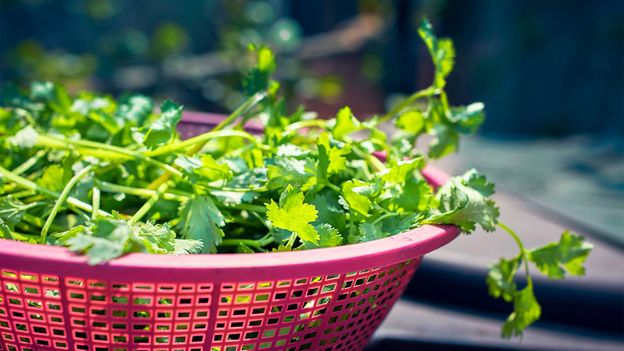
The unsung hero of Indian cuisine
[ad_1]
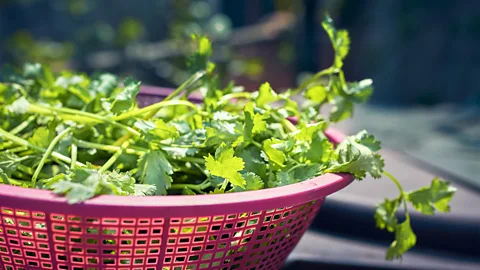 Suprabhat Dutta/EyeEm/Getty Images
Suprabhat Dutta/EyeEm/Getty ImagesA polarising ingredient in much of the world, coriander is an unsung hero of Indian cuisine. And one chef wants to bring it into the limelight, giving it “the glory it deserves”.
Peek inside any Indian spice box, and you’ll likely find the holy trifecta of spices – turmeric, red chilli powder and ground coriander (often mixed with cumin) – that forms the base of many a curry, lentil or vegetable dish.
Though it lacks the striking ochre hue of haldi (turmeric) and isn’t associated with any of India’s signature red-hot flavours (like chilli powder), coriander (commonly called dhaniya or kothmir in India) is perhaps the most versatile of these spices. Its coarsely ground seeds bring warmth and nuttiness to many dishes, while as a powder, it can be used to thicken curries. As an herb, its fresh stalks and leaves often serve as an aromatic and tangy finishing flavour.
It’s so customary to Indian cooking that pushcart vendors will cheerfully toss a complimentary bunch of fresh coriander (as well as a handful of green chillies) into customers’ bags. Its sheer ubiquity makes it a hero – albeit an unsung one – of Indian cuisine.
Elsewhere in the world, though, dislike towards the herb form of coriander is fierce. Dedicated social media communities diligently denounce it, even commemorating their distaste annually with an international I Hate Coriander Day on 24 February. While those who appreciate the herb describe it as fresh, fragrant and citrusy, those who loathe it claim that it tastes like soap, dirt or bugs – often citing that the name coriander itself comes from the Greek word koris, meaning “bedbug” due to its pungent smell.
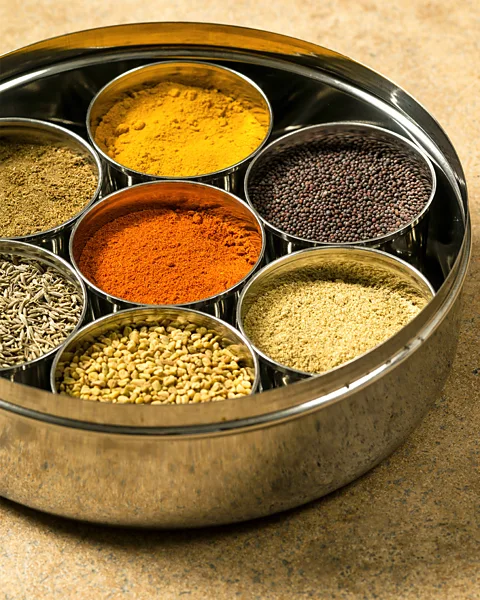 Ron Sumners/Alamy
Ron Sumners/AlamyTo South Asians, coriander is much more than just a garnish. Instead of tossing copious amounts of it onto completed dishes as an afterthought – as is customary for the stereotypical “exported” dishes the West most readily associates with Indian cuisine such as tikka masala – South Asians use it deliberately throughout different parts of the cooking process and in many dishes.
What’s in a name?
In the UK and other European nations, coriander refers to both the herb and the spice form of the ingredient. However, in the US, the word “cilantro” refers to the fresh herb, while “coriander” refers only to the spice. In India, the word for coriander, “dhaniya”, is regularly married off to various other ingredients in the same breath – for instance, dhaniya-jeera (a foundational ground coriander and cumin blend), dhaniya-pudina (mint and coriander) and dhaniya-mirchi (a popular chutney combination).
While preparing a gravy, coriander powder is typically used alongside turmeric and cumin to add bulk and a slightly sour undertone. Coriander seeds might be added to a tadka, a technique of tempering or “blooming” spices and aromatics by frying them in hot oil and adding them to a dish to infuse and unlock flavour, while leaves are often ground into a tantalising chutney or added sparingly to a yoghurt-based raita. Fresh coriander can also be finely chopped and sprinkled delicately on dishes as a final flourish.
Still, while coriander might be thoroughly enmeshed with Indian cooking, it’s often uncelebrated in the kitchen – its sheer affordability, accessibility and ubiquity leading it to be taken for granted. However, one chef, Ranveer Brar, is trying to change all that.
“Growing up in a Punjabi household, coriander was a very important part of what we ate as a farming family. We’d throw coriander seeds near the water canals, and they’d just sprout there and we’d pluck some to throw in [to our food],” said the author, restaurateur and MasterChef India judge.
As he delved deeper into Indian cooking and travelled extensively throughout India, Brar began to appreciate coriander’s various uses throughout regional Indian cuisines.
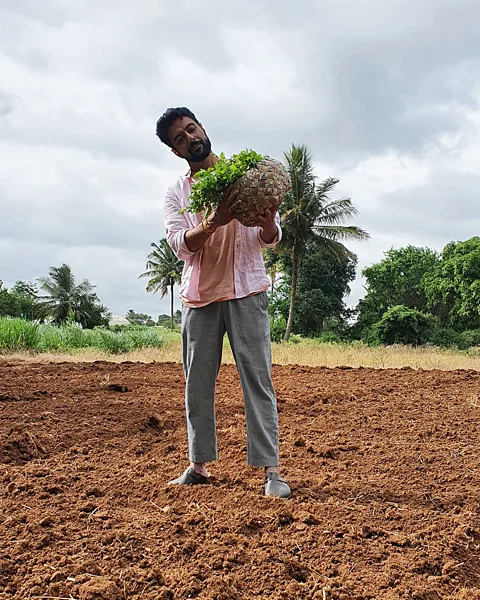 Ranveer Brar
Ranveer Brar“From North to South India, [many] states and regions use coriander. Whether it’s as a raw paste or chutney, used with coconut, or the longer fern-like variant in Northeast India that is juicier and deeper, coriander is firmly a part of the cooking repertoire,” he explained. “I like to think of it as a little sensory trigger. The nose comes into play and the entire dish is elevated.”
Yet, the fact that coriander is little appreciated or formally recognised bothered Brar. So, in March 2022, inspired by the traction he received from a lighthearted social media post voicing the same sentiment, he started a petition on Change.org to give humble dhaniya “the glory it deserves” by calling for it to be designated the “national herb of India”. So far, the petition has amassed nearly 32,000 of the 35,000 signatures required to make it one of the top signed on the platform.
According to Change.org’s marketing campaigns manager, Madhuri Janaki Zutshi, 87% of the signatures have come from people in India, while the remaining include members of the Indian diaspora. And many shared Brar’s love for it in the comments section of the petition: “Food without dhania is like a princess without her tiara …. I love dhania,” reads one comment; “Indeed, coriander is our national herb, without which we can’t think our dish is complete,” reads another.
The issue has been escalated by Change.org to Pashupati Kumar Para, the Minister of Food Processing Industries in India, who is the stakeholder for officially designating it as the country’s national herb. The petition’s success, said Zutshi, will ultimately be decided by Brar based whether there are tangible results – something he will mark by a red victory flag, which will appear on the petition page above the final signature count.
 Ranveer Brar
Ranveer BrarNevertheless, the petition’s ultimate success is perhaps more about an ongoing process than just an end goal. “We believe petitions that move the needle on an issue are successful in their own way,” Zutshi said. For Brar, the call to make coriander India’s national herb wasn’t about activism.
“It was creating this thought and starting a national conversation,” he said. “If Italy has basil and France has marjoram, what is India’s ‘it’ herb? Why can’t we give coriander – that symbolises so much in our country – that space in our heads?”
In fact, the ingredient’s place in South Asia cuts much deeper than cooking alone. “Coriander has long been our kitchen doctor,” said Pakistani herbalist Dr Bilquis Shaikh.
While the use of coriander dates back millennia and it’s consumed all over the world, in India it traces back to the Vedas and Sanskrit writing (from 6000 BCE and 1500 BCE, respectively), and has long been used as a medicinal herb and functional food promoting wellness in traditional medicine.
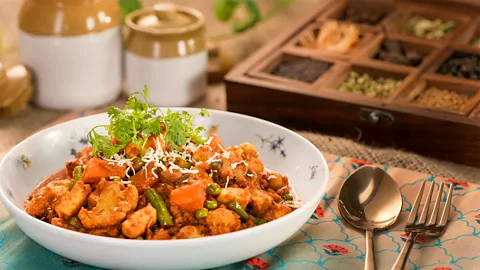 Ranveer Brar
Ranveer BrarShe recommends having coriander mixed with fennel as a time-tested remedy for indigestion, and drinking 20-25 coriander leaves boiled in milk for immediate relief from backaches and menstrual cramps. Shaikh deploys coriander in multiple decoctions – to treat mouth ulcers, boils on the scalp and even hallucinatory insomnia – and describes the herb as having a cooling taseer or therapeutic effect on the body, particularly beneficial in the subcontinent’s hot weather.
Even mainstay dishes in Indian cooking, such as raw mint-coriander-tomato chutney, have a light, zingy and refreshing effect – something that fits with the land just as, say, a decadently creamy soup would intuitively make sense in a cooler climate.
In fact, many medicinal uses for coriander may have stemmed from different regions due to their environments and then crossed over to culinary domains.
For instance, Brar explained that “hard” lake water (which is high in dissolved minerals like calcium and magnesium) in the city of Bhopal historically didn’t sit well with early settlers, who began consuming coriander to alleviate symptoms of indigestion. This may, he posited, have birthed the region’s signature dish, Bhopali rezala, a robust whey and yoghurt-based curry with copious amounts of coriander.
While it’s clearly a versatile ingredient in both medicinal and culinary applications, coriander’s most important trait might very well be that every part of the plant can be used.
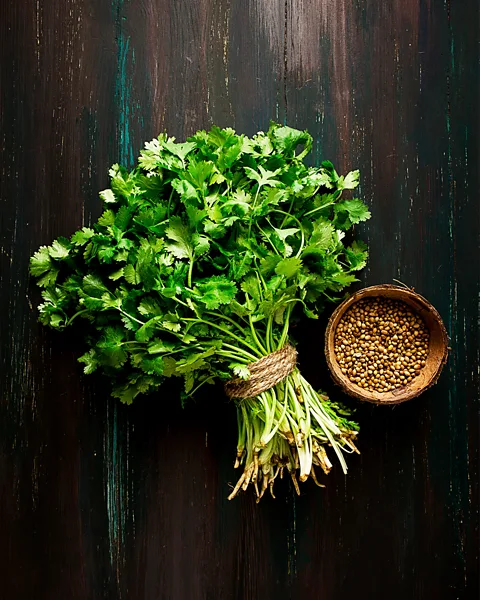 Galina Loginova/Getty Images
Galina Loginova/Getty Images“Today, we fancifully talk about ‘root-to-fruit’ consumption patterns to reduce waste,” said Brar, “But coriander has always been that guy.” The longer the anticipated cooking time, “the lower you go,” meaning “lower” in the anatomy of the plant, from the leaf to the stalk, root and seed.
Coriander roots, for instance, impart a deep, woody flavour in the city of Lucknow’s celebrated nihari, a sumptuous, slow-cooked meat stew. A muslin-wrapped pouch with coriander seeds – along with other spices such as cloves, cinnamon sticks, cumin seeds and peppercorns – are often simmered for hours on end to extract a full-bodied and deep broth, often used to make pulao, a dish similar to rice pilaf. The delicate, fresh leaves can be added at the end of preparing a dish.
“Like perfumery, coriander has top, mid and deep notes. The leaves are like cologne – you dab some on top; it stays for a bit [then dissipates]. But the roots are [long-lasting] musk – oud,” he continued.
Cookbook author Saira Hamilton particularly likes cooking with the bottom parts of the plant. “The roots and stalks are probably the best part,” she said. “Often scorned by Western chefs, the stalks of coriander, if bitten into raw, have a juicy pop of flavour which I adore. Pounded down with green chilli and salt, [coriander roots] are like a taste explosion for any masala [spice blend].”
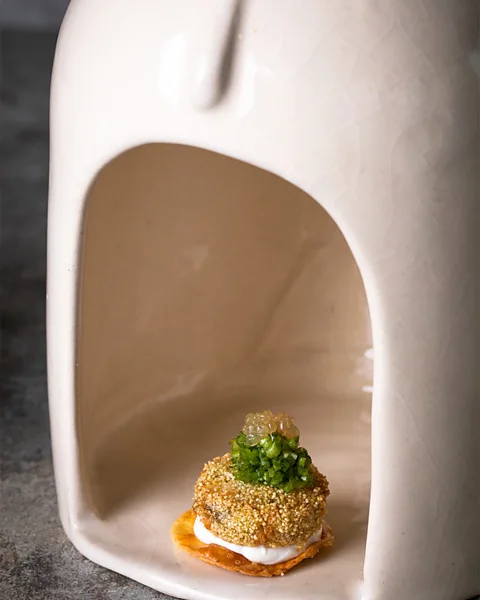 Restaurant Gaa
Restaurant GaaAccording to Garima Arora – the first Indian woman to earn a Michelin star and chef-owner of restaurants Gaa and HERE in Bangkok, Thailand – using coriander is meant to be a very intentional act, one where the chef is acutely aware of the type of emboldened “greenness” he or she is inviting into the dish.
Arora’s pork belly with pomegranate, onion and coriander incorporates the herb in two forms, in which coriander stems are processed in oil that’s made from coriander leaves, adding both texture and a very distinct “green” flavour. “You’ve got pomegranate bringing in sweetness, acidity from onions and lime, and green from the coriander for the texture as well as a burst of fresh, green juice,” she explained.
While Arora believes that coriander is the herb that can be most easily associated with Indian food – and, for what it’s worth, she says she’s “never met an Indian with that soapy gene aversion” – to say it’s India’s “official” herb is discounting the many various flavours of regional cuisines.
In a land teeming with so much culinary diversity, perhaps there are many contenders for a “national herb”. And Brar is okay with that. For him, the question has never been, “Why coriander and not X?” but rather, “Why not coriander?”
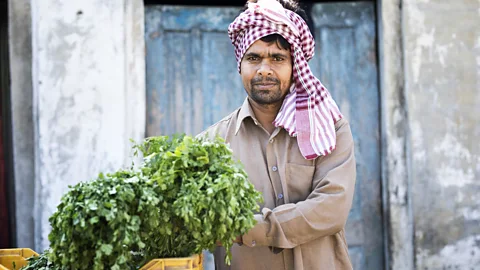 triloks/Getty Images
triloks/Getty ImagesHe says that coriander embodies “the joy of culmination – of finishing a dish well”. “It’s the difference between ghazaiyat (nutrition) and nafasat (exquisite refinement),” he continued. “It’s the difference between food that satiates and food that stimulates.”
Ultimately, it seems, Brar’s campaign is more about giving coriander recognition in the soul of Indian cuisine than as a national dish. When asked if he would he ever consider opening an Indian restaurant without coriander, his answer was blunt: “You can’t.”
BBC.com’s World’s Table “smashes the kitchen ceiling” by changing the way the world thinks about food, through the past, present and future.
[ad_2]
Source link





